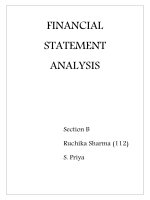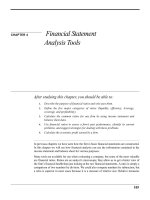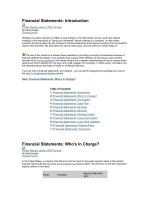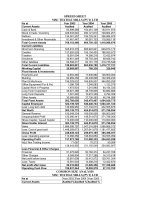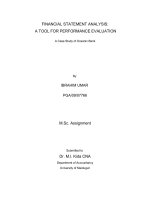Financial statement analysis workbook
Bạn đang xem bản rút gọn của tài liệu. Xem và tải ngay bản đầy đủ của tài liệu tại đây (6.48 MB, 447 trang )
Financial Management and
Analysis
Workbook
THE FRANK J. FABOZZI SERIES
This workbook is the companion, self-study guide to Financial Management and
Analysis: Second Edition.
Please visit www.WileyFinance.com for more information.
Fixed Income Securities, Second Edition by Frank J. Fabozzi
Focus on Value: A Corporate and Investor Guide to Wealth Creation by James L.
Grant and James A. Abate
Handbook of Global Fixed Income Calculations by Dragomir Krgin
Managing a Corporate Bond Portfolio by Leland E. Crabbe and Frank J. Fabozzi
Real Options and Option-Embedded Securities by William T. Moore
Capital Budgeting: Theory and Practice by Pamela P. Peterson and Frank J. Fabozzi
The Exchange-Traded Funds Manual by Gary L. Gastineau
Professional Perspectives on Fixed Income Portfolio Management, Volume 3 edited
by Frank J. Fabozzi
Investing in Emerging Fixed Income Markets edited by Frank J. Fabozzi and
Efstathia Pilarinu
Handbook of Alternative Assets by Mark J. P. Anson
The Exchange-Traded Funds Manual by Gary L. Gastineau
The Global Money Markets by Frank J. Fabozzi, Steven V. Mann, and
Moorad Choudhry
The Handbook of Financial Instruments edited by Frank J. Fabozzi
Collateralized Debt Obligations: Structures and Analysis by Laurie S. Goodman
and Frank J. Fabozzi
Interest Rate, Term Structure, and Valuation Modeling edited by Frank J. Fabozzi
Investment Performance Measurement by Bruce J. Feibel
The Handbook of Equity Style Management edited by T. Daniel Coggin and
Frank J. Fabozzi
The Theory and Practice of Investment Management edited by Frank J. Fabozzi and
Harry M. Markowitz
Foundations of Economic Value Added: Second Edition by James L. Grant
Financial Management and Analysis: Second Edition by Frank J. Fabozzi and
Pamela P. Peterson
Measuring and Controlling Interest Rate and Credit Risk: Second Edition by
Frank J. Fabozzi, Steven V. Mann, and Moorad Choudhry
Professional Perspectives on Fixed Income Portfolio Management, Volume 4 edited
by Frank J. Fabozzi
Handbook of European Fixed Income Securities edited by Frank J. Fabozzi and
Moorad Choudhry
Credit Derivatives: Instruments, Applications, and Pricing by Mark J.P. Anson,
Frank J. Fabozzi, Moorad Choudhry, and Ren-Raw Chen
Handbook of European Structured Financial Products edited by Frank J. Fabozzi
and Moorad Choudhry
Financial Management and
Analysis
Workbook
Step-by-Step Exercises and Tests to Help You Master
Financial Management and Analysis
PAMELA P. PETERSON
FRANK J. FABOZZI
WENDY D. HABEGGER
John Wiley & Sons, Inc.
Copyright © 2004 by Frank J. Fabozzi, Pamela P. Peterson, and Wendy Habegger. All rights
reserved.
Published by John Wiley & Sons, Inc., Hoboken, New Jersey
Published simultaneously in Canada
No part of this publication may be reproduced, stored in a retrieval system, or transmitted in
any form or by any means, electronic, mechanical, photocopying, recording, scanning, or otherwise, except as permitted under Section 107 or 108 of the 1976 United States Copyright
Act, without either the prior written permission of the Publisher, or authorization through
payment of the appropriate per-copy fee to the Copyright Clearance Center, Inc., 222 Rosewood Drive, Danvers, MA 01923, 978-750-8400, fax 978-750-4470, or on the web at
www.copyright.com. Requests to the Publisher for permission should be addressed to the Permissions Department, John Wiley & Sons, Inc., 111 River Street, Hoboken, NJ 07030, 201748-6011, fax 201-748-6008, e-mail:
Limit of Liability/Disclaimer of Warranty: While the publisher and author have used their best
efforts in preparing this book, they make no representations or warranties with respect to the
accuracy or completeness of the contents of this book and specifically disclaim any implied
warranties of merchantability or fitness for a particular purpose. No warranty may be created
or extended by sales representatives or written sales materials. The advice and strategies contained herein may not be suitable for your situation. You should consult with a professional
where appropriate. Neither the publisher nor author shall be liable for any loss of profit or
any other commercial damages, including but not limited to special, incidental, consequential,
or other damages.
For general information on our other products and services, or technical support, please contact our Customer Care Department within the United States at 800-762-2974, outside the
United States at 317-572-3993, or fax 317-572-4002.
Wiley also publishes its books in a variety of electronic formats. Some content that appears in
print may not be available in electronic books.
For more information about Wiley, visit our web site at www.wiley.com.
ISBN: 0-471-47761-3
Printed in the United States of America
10 9 8 7 6 5 4 3 2 1
Contents
PART ONE
Questions and Problems
CHAPTER 1
Introduction to Financial Management and Analysis
1
3
CHAPTER 2
Securities and Markets
11
CHAPTER 3
Financial Institutions and the Cost of Money
17
CHAPTER 4
Introduction to Derivatives
25
CHAPTER 5
Taxation
35
CHAPTER 6
Financial Statements
43
CHAPTER 7
Mathematics of Finance
53
CHAPTER 8
Principles of Asset Valuation and Investment Returns
65
CHAPTER 9
Valuation of Securities and Options
75
v
vi
CHAPTER 10
Risk and Expected Return
Contents
87
CHAPTER 11
The Cost of Capital
101
CHAPTER 12
Capital Budgeting: Cash Flows
109
CHAPTER 13
Capital Budgeting Techniques
117
CHAPTER 14
Capital Budgeting and Risk
127
CHAPTER 15
Intermediate and Long-Term Debt
139
CHAPTER 16
Common Stock
151
CHAPTER 17
Preferred Stock
163
CHAPTER 18
Capital Structure
173
CHAPTER 19
Management of Cash and Marketable Securities
183
CHAPTER 20
Management of Receivables and Inventory
193
CHAPTER 21
Management of Short-Term Financing
203
CHAPTER 22
Financial Ratio Analysis
213
CHAPTER 23
Earnings Analysis
227
Contents
vii
CHAPTER 24
Cash Flow Analysis
237
CHAPTER 25
International Financial Management
245
CHAPTER 26
Borrowing via Structured Finance Transactions
257
CHAPTER 27
Equipment Leasing
263
CHAPTER 28
Project Financing
273
CHAPTER 29
Strategy and Financial Planning
279
PART TWO
Solutions
289
CHAPTER 1
Introduction to Financial Management and Analysis
291
CHAPTER 2
Securities and Markets
295
CHAPTER 3
Financial Institutions and the Cost of Money
299
CHAPTER 4
Introduction to Derivatives
303
CHAPTER 5
Taxation
309
CHAPTER 6
Financial Statements
315
viii
Contents
CHAPTER 7
Mathematics of Finance
319
CHAPTER 8
Principles of Asset Valuation and Investment Returns
325
CHAPTER 9
Valuation of Securities and Options
329
CHAPTER 10
Risk and Expected Return
335
CHAPTER 11
The Cost of Capital
341
CHAPTER 12
Capital Budgeting: Cash Flows
345
CHAPTER 13
Capital Budgeting Techniques
351
CHAPTER 14
Capital Budgeting and Risk
359
CHAPTER 15
Intermediate and Long-Term Debt
365
CHAPTER 16
Common Stock
371
CHAPTER 17
Preferred Stock
377
CHAPTER 18
Capital Structure
381
CHAPTER 19
Management of Cash and Marketable Securities
385
CHAPTER 20
Management of Receivables and Inventory
391
Contents
ix
CHAPTER 21
Management of Short-Term Financing
395
CHAPTER 22
Financial Ratio Analysis
401
CHAPTER 23
Earnings Analysis
407
CHAPTER 24
Cash Flow Analysis
413
CHAPTER 25
International Financial Management
417
CHAPTER 26
Borrowing via Structured Finance Transactions
421
CHAPTER 27
Equipment Leasing
425
CHAPTER 28
Project Financing
429
CHAPTER 29
Strategy and Financial Planning
433
PART
One
Questions and Problems
CHAPTER
1
Introduction to Financial
Management and Analysis
FILL IN THE BLANKS
Refer to Chapter 1, pages 3–24 in Financial Management
and Analysis.
1. ______________ is the application of economic principles
and concepts to business decisions and problem solving. It
can be divided into three categories: ______________,
______________, and ______________. ______________ is
the management of a firm’s cash flow to increase shareholder wealth.
2. ______________ and ______________ are decisions made
concerning financial management. Financial managers
compare potential ______________ and ______________,
otherwise known as expected returns. The uncertainty
inherent with these returns is referred to as the
______________.
3
4
QUESTIONS AND PROBLEMS
3. The evaluation of the financial condition and operating
performance of a business firm, industry, and economy,
and future forecasting of its condition and performance is
known as ______________. It is also used to evaluate specific ______________ and ______________ within a firm
and the overall ______________ and ______________ outside the firm.
4. ______________, ______________, and ______________
are the three major forms of business organizations. The
______________ provides the largest percentage of U.S.
business incomes, but the majority of businesses are
______________. Proprietors and ______________ partners
are liable for only business debts, whereas ______________
partners and the owners of a(n) ______________ stand to
lose only the initial investment.
5. The ______________ are the contract between the shareholders and corporation and authorizes the corporation to
issue stock. The ______________ of a corporation are rules
of governance. The owners of a corporation are also called
the ______________. They elect a(n) ______________ for
representative purposes in the major business decisions.
A(n) ______________ corporation is owned by a multitude of share holders while a(n) ______________ is
owned by a few shareholders. Corporations whose
shares are publicly traded must file financial statements
with the ______________.
Introduction to Financial Management and Analysis
5
6. ______________ and ______________ business income are
subject to the personal income tax rate of the individual
owners, whereas a(n) ______________ pays taxes as a separate legal entity. Cash distributions to shareholders are
also taxed as personal income of the owner, leading to
what is known as ______________.
7. A hybrid form of business is a(n) ______________ and it
combines the best features of a(n) ______________ and a(n)
______________. These types of businesses are treated as a
partnership for ______________ purposes, while the owners
are not ______________ for firm obligations. A(n)
______________ is a popular form of business that is commenced by a group of persons or entities for a specific
business activity in which the relationship only lasts the
length of the activity. It may also be structured as a(n)
______________ or a(n) ______________ and is treated
according to how it is structured.
8. The single financial goal is to maximize the ______________
wealth, which means to maximize the ______________ of a
share of stock for a corporation. The market value of shareholders’ equity is the product of the price of ______________
and the number of ______________, which are the total
number of shares owned by shareholders. The stock price
is equal to the ______________ of all expected future cash
flows to owners. In a(n) ______________, the price of a
stock reflects all publicly available information so the
investor is unlikely to earn ______________ profits by trading on information already known to the public. The only
6
QUESTIONS AND PROBLEMS
way for an investor to increase the return is to increase the
______________.
9. ______________ profit is the difference between revenues
and costs, where costs are the unambiguous costs of doing
business. ______________ profits include both explicit and
implicit costs. Maximization of ______________ profits
maximizes owners’ wealth.
10. A(n) ______________ is a person acting in the best interest
of another person or group of people. The ______________
is the person or group being represented. Three types of
agency costs are ______________, ______________, and
______________. Interests of management and shareholders are aligned when executive compensation packages
are designed to encourage ______________-term investment by managers in the stock of the corporation. In particular, ______________ and ______________ might be
the better forms of compensation as they require the manager to be an owner in the corporation and hold stock for
a specified time.
Introduction to Financial Management and Analysis
7
SHORT ANSWER QUESTIONS
Refer to Chapter 1, pages 3–24 in Financial Management
and Analysis.
1. According to market efficiency, if investors who trade on
publicly available information are unlikely to earn abnormal profits, then should small investors not invest in the
stock market?
2. What are accounting profits or economic profits and
which one should an investor be more concerned with?
8
QUESTIONS AND PROBLEMS
3. Why might a restricted option compensation program be
more effective than a performance shares program in motivating managers to maximize the wealth of the owners?
4. An article in today’s Wall Street Journal states a certain
drug company has received approval from the Federal
Food and Drug Administration to market a new medication for people with heart disease. You believe you should
call your broker and invest in the stock of this company
immediately because it will undoubtedly increase in value.
Given what you know about efficient markets, what
advice do you suspect you will receive from your broker?
Introduction to Financial Management and Analysis
9
5. Annie and Alice invested $50,000 and $25,000 respectively in a business enterprise. During the first year of
operation, the business had taxable income of $12,000.
a. If the business is organized as a partnership, with profits
and losses shared based on the proportion of each partner’s original investment, how much of the income will
each claim on her personal tax return?
b. After the initial year of success, a weakened economy
caused the business to falter. Following four successive
years of losses, the assets of the business were $30,000
and the debts were $50,000. The two owners decided to
liquidate the business. What are the financial consequences of the dissolution of the business to each owner?
10
QUESTIONS AND PROBLEMS
c. If the business had been a limited partnership, with
Annie being the general partner who actively ran the
business, what would the financial consequences be for
each owner?
d. If the business had been a corporation with ownership
interests based on the proportion of each woman’s initial
investment, what would the financial consequences be
for each owner?
CHAPTER
2
Securities and Markets
FILL IN THE BLANKS
Refer to Chapter 2, pages 27–47 in Financial Management
and Analysis.
1. A(n) ______________ is a claim on future cash flows. A(n)
______________ is a where securities are bought and sold.
Securities are classified into three groups: ______________
securities, ______________ securities, and ______________
securities. ______________ securities have a one year or less
original maturity. ______________ securities are long-term
securities issued by corporations and governments.
2. ______________ is short-term debt of a large corporation
with good credit standing. A(n) ______________ is the
U.S. government’s short-term debt. ______________ certificates of deposit are issued by large ______________ and
are often transferred among investors.
3. ______________ is the ownership interest in a corporation.
______________ are the called the residual owners of the
firm. Common stock has ______________ maturity. Cash
payments to shareholders are called ______________.
______________ stockholders are guaranteed a fixed dividend, but are not residual owners of the firm.
11
12
QUESTIONS AND PROBLEMS
4. On a debt security, the ______________ refers to the borrowed monetary amount. The ______________ are periodic
payments. Debt securities with less than 10 years to maturity are called ______________. ______________ bonds are
debt of state and local governments. These bonds interest
payments are exempted from ______________ taxes.
______________ bonds are backed by the issuer’s taxing
power. ______________ bonds are backed by the proceeds
of a specific project. Bond trading is mostly done in the
______________ market, although small orders are traded
on ______________.
5. The ______________ market is where new capital is
raised, whereas the ______________ market is where a
shift in funds occurs between investors. Capital is raised
in the primary market through ______________, which
are direct sales of the issues to investors, and through
______________ agreements, which are when investment
bankers purchase the securities for immediate resale to
the public.
6. ______________ are actual physical markets in which
shares are traded. Transactions in the ______________
market occur over computers and phone lines. The organized exchanges in the U.S. are ______________ owned.
Exchanges in other countries are often controlled by
______________ or ______________. There is U.S. government regulation of the financial markets. In particular,
The Securities Act of 1933 requires that new securities be
Securities and Markets
13
______________. The Securities and Exchange Act of 1934
established the ______________ Commission.
7. The largest exchange in the United States in terms of market
value of the shares traded is the ______________. The other
national exchange is the ______________. There are seven
______________ exchanges that trade ______________ listed
securities. The largest over-the-counter market for common
stock is known as ______________ and it is a computerized
quotation system. The larger, most actively traded securities
in NASDAQ are included in the ______________. The NASDAQ system is the ______________ largest market for securities. The Dow Jones Industrial Average is computed using
______________ stocks. The S&P 500 is an index of
______________ companies’ stocks.
8. A(n) ______________ market is one where asset prices quickly
reflect all information that is available. ______________ form
market efficiency means current prices reflect all past prices so
investors cannot earn ______________ profits based on past
price movements. The ______________ form of market efficiency indicates security prices incorporate all information
that is available to the public. Empirical evidence suggests
that U.S. security markets are ______________ form efficient.
______________ form market efficiency implies investors will
not earn abnormal profits trading on information that is private. Recent events suggest abnormal profits may be gained
by ______________ trading.
14
QUESTIONS AND PROBLEMS
SHORT ANSWER QUESTIONS
Refer to Chapter 2, pages 27–47 in Financial Management
and Analysis.
1. How do stocks differ from bonds?
2. How do common stocks differ from preferred stock?





